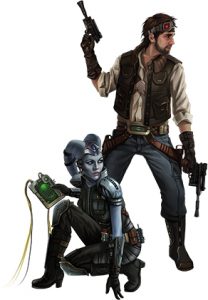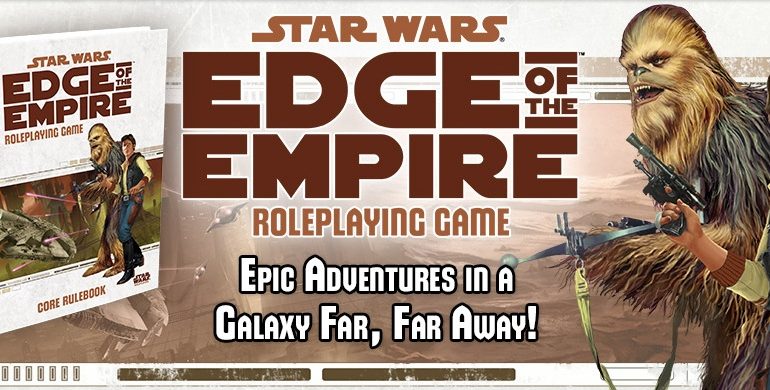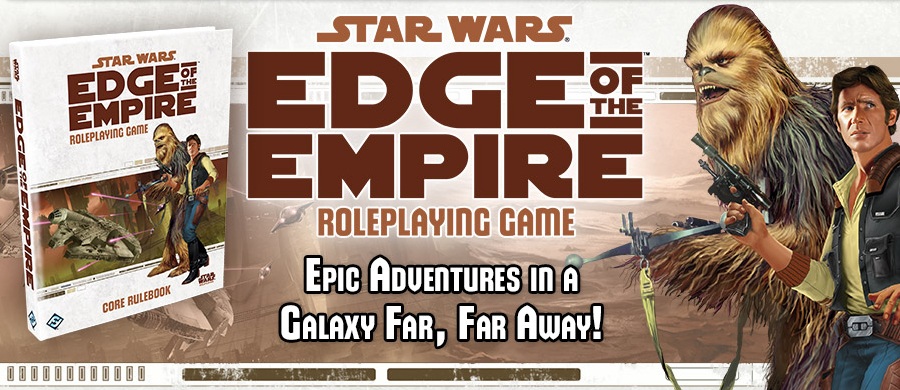Star Wars: Edge of the Empire
The confession that’s going to get me fired from this website: I’m not that into Star Wars. I sure don’t like dislike it, but I’ve never delved into the EU, can’t remember the names of any races besides Wookiees, Ewoks, and Twi’leks*, and just in general don’t have room in the withered black cockles of my heart for that particular fandom. In the circles I move in, this ranges from slightly odd but irrelevant to essentially leprosy, complete with pieces of my body falling off. After someone cuts them off.
*Twi’leks are the ones with backswept tentacle heads, right? If not, then I guess I just know Wookiees and Ewoks.
But when the question “Hey, we wanna try the new Star Wars tabletop?” was put before my weekly gaming group, I wasn’t gonna be a killjoy about it. We had a starter kit with pre-gen characters, a GM who’d run the adventure before, and no D&D to play, so why the hell not? Besides…I got to be a Wookiee. You can’t turn that down.
Edge of the Empire is by Fantasy Flight Games, and uses one of their signature proprietary dice systems, which comes with a little built-in silliness – as Jon put it, “I roll three lightsabers, two Imperial symbols, Yoda ears and Lando. Do I hit?” But once you get used to reading the bones, it’s actually a pretty elegant little system; you’re aiming for more Successes (explosion!) than Failures (sinister triangle!) to get something done. You can also roll Advantage (Rebel symbol?!), which lets you accomplish secondary goals, boost your allies, or affect the narrative, as well as Threat (targeting lock or something!) which lets the GM do the opposite.

To be fair, I would definitely play a game with Billy Dee Williams’ face as a die result.
The neat, elegant thing about this is that Success/Failure and Advantage/Threat can work totally independently of each other, allowing you to succeed in your goal and still rack up negative consequences, or vice versa. For example, one of our players, firing at a couple droids, missed badly but rolled piles of Advantage, which he was able to then use to have his wild shots blow up a coolant tank and blind the droids for a round. Mechanics, like that, allowing you to “fail forward,” are a great break from the relatively binary dice of most d20 systems. In addition, the dice are basically divided into “good dice” and “bad dice” – you roll more and better dice with Success/Advantage/TRIUMPH!* results as you level up, you roll more and worse dice with Failure/Threat/DESPAAAIIIR** results as you undertake more difficult checks.
*Triumph and Despair are rare results on the twelve-sided dice used for well-trained skill checks and particularly difficult circumstances; you inflict or suffer crippling conditions, boost or penalize your next action, or just get a non-mechanical narrative boost at GM discretion.
**”Mutant palm tree” and “very sinister triangle,” respectively.
The caveat to all this, of course, is that a system with results so open to interpretation requires flexibility on the part of the GM and trust on the part of the players. While there are a few hard & fast rules for what you can do with various levels of Advantage or Threat, a lot of it is purely abstract. Similarly, while the starter kit provides a few encounter maps and PC/NPC tokens, it doesn’t snap to grid and positioning is simply measured in distance factors and whether you’re engaged in melee with a target or not. When there’s no exact right answer to an ingame question, you have to trust the judgment of your GM, and the GM has to be willing to rethink a decision based on player input. Our one-shot had success with that, but it’s a meta-game challenge that not all groups are going to want to handle on a regular basis.

Skills not taken: “Trustworthy.”
What else? Things seem reasonably well balanced, with ties going to the GM but the die results, on average, favoring the players. As far as the “RP” part of “RPG” goes, well, it’s Star Wars. EotE takes place around the time of the first movie, pre-Death Star I think. I dunno, I was a Wookiee. I yelled at lizard aliens and hit things with a vibro-axe. But my compatriots, better-versed in all things Star Wars, seemed satisfied with the flavor, and Fantasy Flight recognized the inherent issue in their setting – the overpowered, plot-hijacking nature of Jedi – and went with what I think is the correct answer, which is “No, you can’t be a Jedi. Fuck off.”
Which brings me to the last game mechanic I want to discuss, the brilliant Force Die. There’s a d12 marked with a variety of single or paired white or black dots, that the GM has each person in the party roll at some story-appropriate point during the game session. (We did ours at the midpoint, before the weapons really came out.) The results generate a pool of white or black bennies, in general around 5-8. The players can spend a white token to change a die (from a “pretty good” d8 to a “really good” d12); the GM can spend a black token to do the same. The awesome thing is that spending a token doesn’t remove it from the game, but flips it over to the other color. So once the Force die is rolled, there’s a pool of bennies that oscillates between “Heroes are winning!” and “Heroes are screwed!” And depending on how often players & GM spend their bennies, that swing can happen pretty often.
I fell in love with this mechanic immediately, because more than anything else, even the “fall forward” dice, it shows that Fantasy Flight gets it. They’re committed to game mechanics that serve the story and the table experience; they explicitly designed the bennie system to make the game more unpredictable and exciting, and did it in a very simple, easy-to-manage way. And in the end, our session (whose plot details I have not addressed cause, you know, SPOILERZ!) was one of the most cinematic one-shots I’ve ever played. If that was the pilot to a Star Wars TV show, I would watch it. And a lot of that is due to the game itself giving players and GM the tools to make sure that all things, even total botches, serve the narrative. If you’re a tabletopper at all, you should give Edge of the Empire a shot; I can’t speak to how well it holds up over a whole campaign, but it starts out really, really well.
Also, someone gets to be a Wookiee with an axe. Come on.






